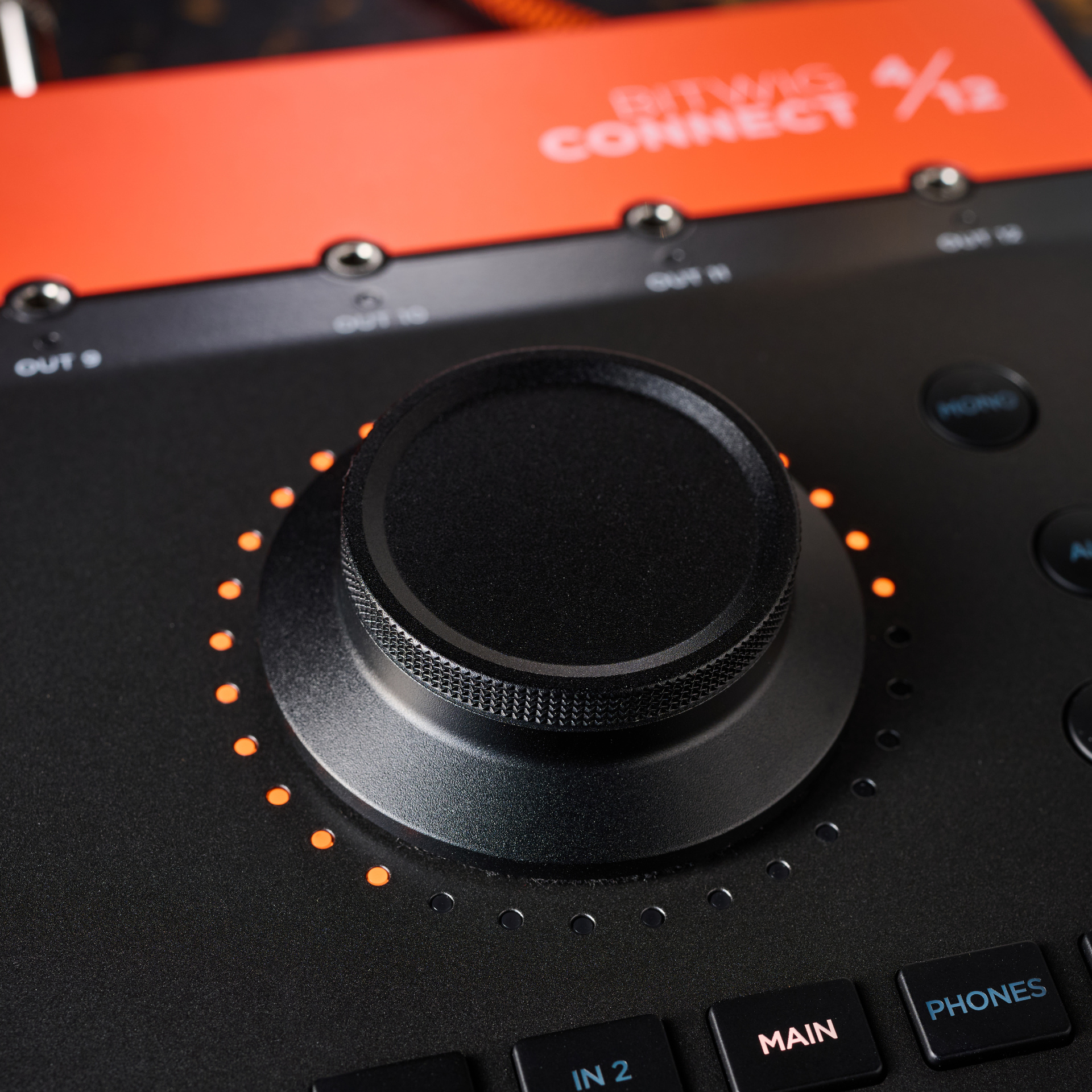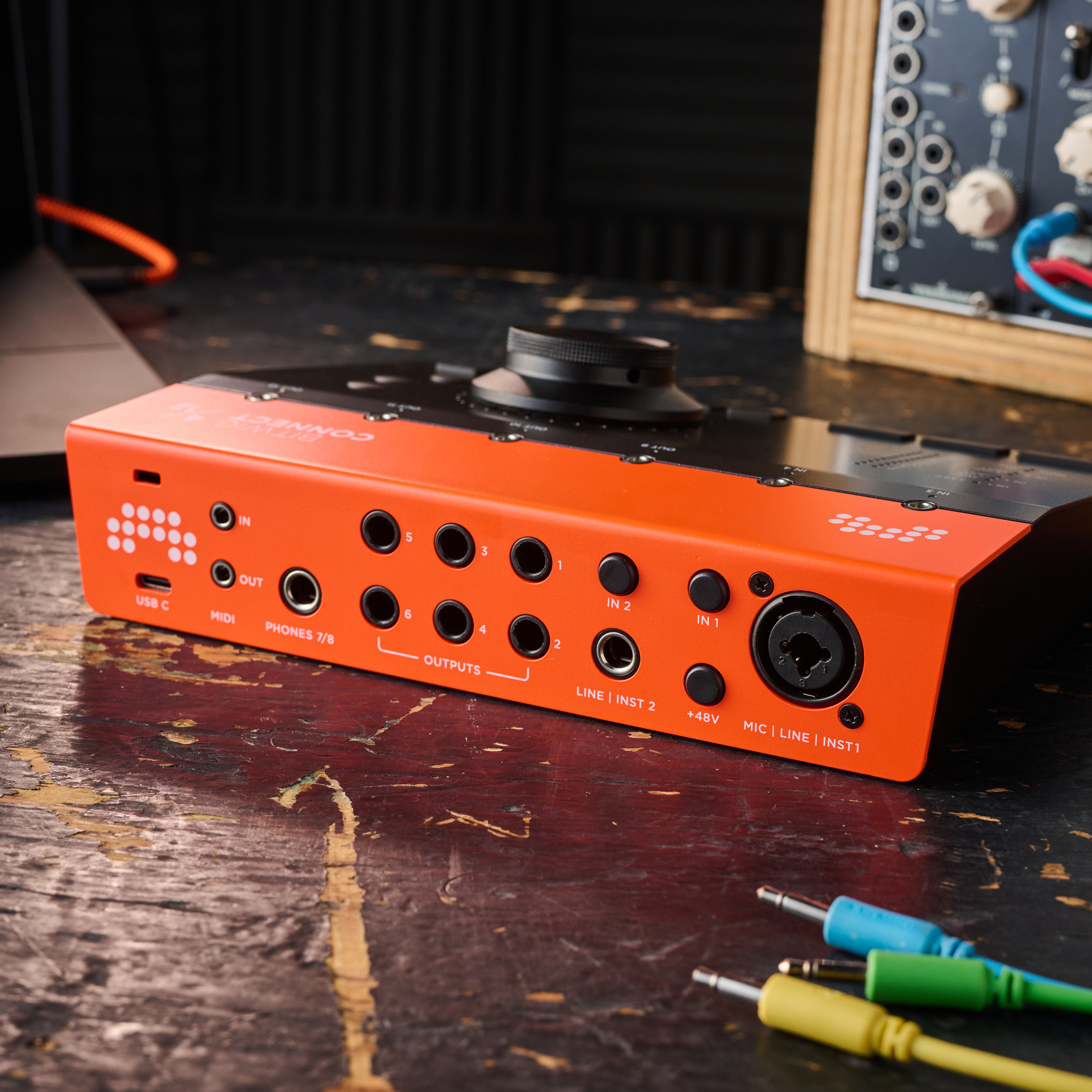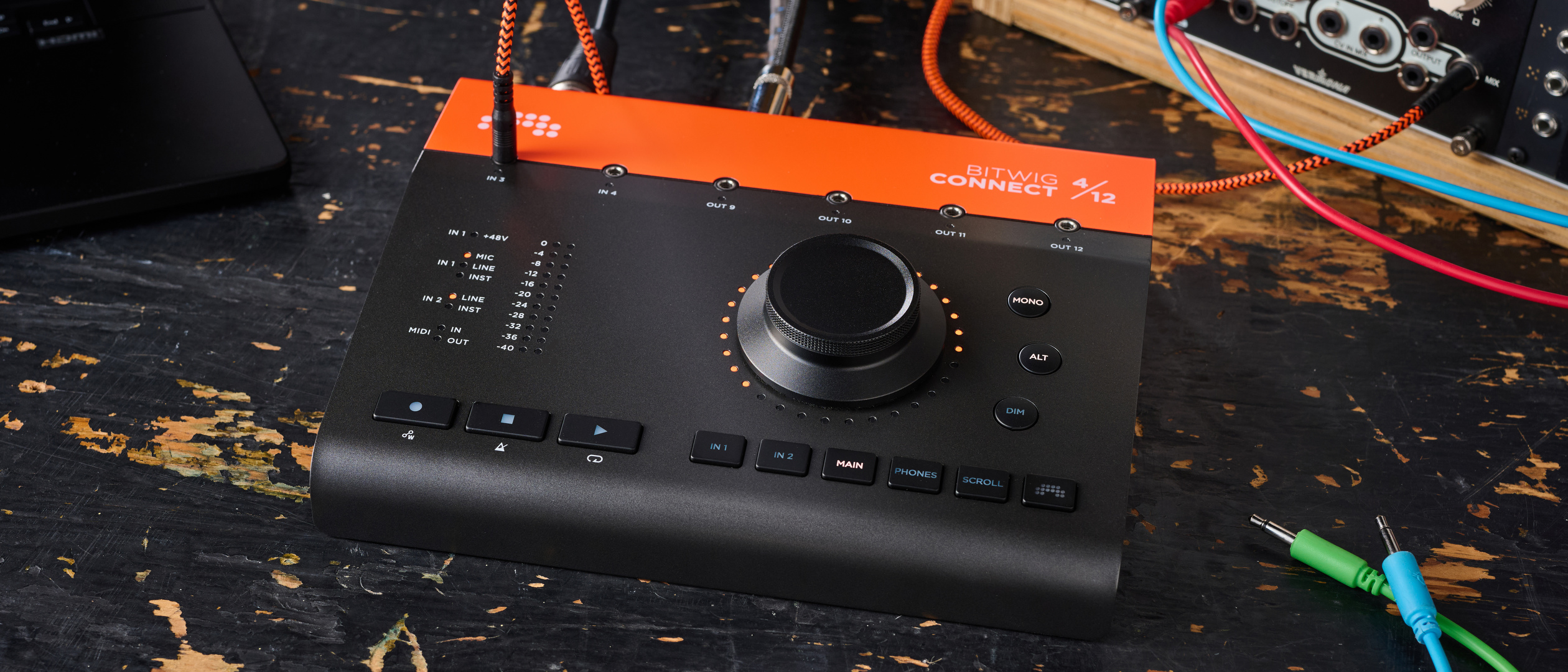MusicRadar Verdict
Bitwig Connect 4/12 has plenty of tools in its armoury, but it's Studio users with a love of modular that will get the most out of this audio interface.
Pros
- +
DC-coupled ports and Eurorack-centric I/O
- +
Flexible routing options
- +
Good integration with Bitwig Studio
Cons
- -
Only one mic pre
- -
Rear controls are a bit fiddly
MusicRadar's got your back
What is it?
For a good while, Bitwig had been quietly working on its first hardware product behind the scenes, and the Berlin-based outfit hadn’t wanted to rush things. On first hearing the news of hardware development, our minds immediately veered towards a controller of some sort - a well-trodden path. However, an audio interface wasn’t very high on the list. I mean, what else can you really bring to market that hasn’t already been done before? Well, it would seem there’s plenty.
Enter Bitwig Connect 4/12, a four-in, 12-out DC-coupled audio interface with MIDI and two virtual loopback channels. In fact, it’s more than your average audio interface with the addition of monitor and DAW transport controls, and some very neat control functionality for all you Bitwig Studio users.
Housed in a very solid metal chassis, the 4/12 is a hefty piece of kit, somewhat reminiscent of the weight and build quality of UA’s Apollo Twin interfaces, complete with a big multi-use dial adorning the faceplate. However, here, the 360-degree rotary is touch-sensitive, so will respond to several different types of gestures, which I’ll go into a bit more detail later.
The I/O is split between two ins and four 3.5mm TS outs located at the top of the front panel and the rest located around the rear, which include: a Mic/Line/Instrument combi port on channel one; a 1/4-inch TRS balanced Line/Instrument jack on channel two; six balanced 1/4-inch TRS balanced outputs (channels one to six); a 1/4-inch stereo headphone output on channels seven and eight; 3.5mm TRS MIDI in and out (breakout cables included); and finally a USB-C/USB2 port for bus-powered connectivity to your computer.
In the box, you’ll find a bright orange and black braided USB-C to C cable, a USB-C to A dongle, two MIDI 3.5mm TRS to 5-pin cables and four braided 3.5mm cables to connect to your outboard gear.

Performance
When it comes to the I/O, it’s inputs three and four and outputs nine to 12 are where all the fun lies, if you’re looking to connect modular devices, that is. The two inputs are switchable between audio or CV signals and as such feature a DC filter that will cut the signal below 20Hz, thus eliminating any unwanted DC offsets when recording audio, and opens a whole ton of options when connecting to your modular set-up. Utilising the CV hardware device in Bitwig Studio with these I/O options is a doddle and you won’t even need to refer to a manual to get things up and running, it’s that easy and intuitive.
The patching options at your disposal here bring your modular and Bitwig even closer than ever before. It has to be said that the real fun lies with the Grid, and again, using the I/O modules, you can easily patch your hardware with the software modules.
Want all the hottest music and gear news, reviews, deals, features and more, direct to your inbox? Sign up here.
I loved the Grid when it first landed with version 3 of Studio, but with Connect, it breathes new life into the virtual modular environment for me. I’ll admit to not owning much in the way of modular hardware, owing mostly to a lack of space, not to mention the question of affordability, so spending out on a Eurorack audio interface and the space to house it has never been high on my list. As such, I’ve never fully explored the Grid with external hardware. Connect 4/12 neatly kills two birds with one stone here, so there’s no worry about having to make extra room in the diminutive modular. The Grid feels even more fun and more powerful than ever.
Control panel
Connect 4/12 comes with an accompanying Control Panel app with opens up even more functionality and gives you full access to the routing and settings. Here you can adjust the sample rate and buffer size and you can easily change channel input settings here from mic, to instrument or line level inputs and also toggle the phantom power on channel one, saving you the faff of fumbling to reach the buttons around the rear of the unit.
There are also deeper settings for the Alt option in the Control Panel. You can select different outputs for wiring up an alternative set of monitors, which are then easily selectable by the Alt button on the hardware.
Levels for everything can be adjusted within the software as well as using the big rotary dial and various button combinations. While the tactility of the dial is most welcome, sometimes you may just want to freely type in an exact value, so having the option for both is great.

Big dial energy
The 360-degree touch-sensitive rotary dial is, hands down, the main attraction here. The two main options to access this power come courtesy of the Scroll and Bitwig buttons located on the bottom right corner of the front panel. As the name suggests, Scroll gives you the ability to easily scroll and zoom your views, but the Bitwig button is where the real fun begins.
Activating Bitwig mode grants you the power to control any parameter by simply hovering your mouse over it, so jumping from one parameter to the next can be as fast as it takes for you to move your mouse around the screen. Both Bitwig and Scroll modes can be used momentarily or latched and you can achieve this in one of two ways: either double-clicking the mode button or by double-tapping the dial itself, and the LEDs will change colour accordingly.
The momentary function will only give you control over a parameter while the mouse pointer is hovering over it. Using the latch function will lock the physical dial to the parameter of your choice, so you can freely move your mouse pointer elsewhere and still have control over said parameter.
It took some getting used to, as I’m so used to solely using a mouse/trackpad, but after a while, activating the Bitwig and Scroll modes was second nature and even more so when using the double-tap function. It’s a simple and yet very effective improvement on using Bitwig Studio. Many of you who already use MIDI controllers in this fashion will likely scoff at its simplicity, but you’ll be hard-pressed to find a hands-on control system as fast and intuitive.
The ‘Double Tap’ function in Bitwig mode can also be customised within Studio’s Controller settings menu. Double tapping by default latches the control, but you can also select the Reset option which will allow you to reset the value of said control. There are also options for setting the speed of the Scroll function and setting the Transport to either pause or return to the original position when stopping playback.

Working well with others
Clearly, most of the testing for this review was using Bitwig Studio, but Connect can work well with other DAWs. The most obvious match is Ableton Live and I found no issues when using the CV tools and connecting to modular gear, as both Live and Studio have their similarities, there’s no surprise here.
I also tried out Connect with Logic Pro, which, like most DAWs, will map multiple outputs ready for multichannel monitoring if you so wish, which is a nice touch. As for CV connectivity, well, you won’t find much af that here, unless you’re using third-party plugins.
It goes without saying that the Scroll and Bitwig buttons won’t have any effect within other DAWs, and the transport buttons won’t straight away either, but Connect 4/12 does support Mackie Control (MCU) protocol, and you can configure this if your DAW supports MCU (they pretty much all do).
Where we did get a bit stuck was when testing it with iOS. Though I must stress that nowhere does Bitwig claim that Connect 4/12 is iOS compatible, so this was merely a test to see if and how it worked with Apple’s mobile operating systems.
On connecting to it to an iPhone 15 Pro and iPhone 16, a warning flashed up stating that the accessory uses too much power to operate. Playback seemed to work from app to app, but when trying to monitor or record in Garageband, there was no signal.
However, with an iPad Air (M2) running iPadOS 18.3.1, I had no such warning with power and the device worked perfectly fine with Garageband able to see all the available channels. Recording and monitoring behaved as expected and even some (not all) of the controls were recognised as MIDI notes when using Alchemy.

Verdict
Bitwig clearly knows its market and knows what its users are looking for when it comes to breaking out of the box. I’ve always found that Studio’s hardware integration options have been top-notch and beat a lot of other DAWs out there and the 4/12 further adds to this.
Connect isn’t the only DC-coupled audio interface out there, but it’s by far the most modular-centric one I’ve come across. The addition and location of the 3.5mm ins and outs are ideal, but if I had one complaint, it’s that everything else is around the rear. I much prefer having headphones in a more accessible location, i.e. the front. Nowadays, many manufacturers even put an instrument input on the front panel too, so I’m thinking that maybe all the I/O should be on the top here?
Another very slight annoyance is that the phantom power and input-type switches are also on the rear. I guess that, visually, it’s better to have an uncluttered interface, but ergonomically, this doesn’t work for me. It’s a bit annoying having to peer around the back of the unit when plugging in cables, let alone having to scrabble around for buttons.
I can see the presence of only one mic pre as off-putting for some, but I don't think it’ll be too much of a deal-breaker. I, for one, rarely need to capture more than one microphone at a time, but those who do might want to look elsewhere.
Connect packs a lot of tools into an already feature-rich box, so I have the feeling that its size and price would be greatly affected by the addition of another mic pre. Perhaps the addition of an optical input for channel expansion would’ve been a good option, but at what cost?
The AKM converters offer industry-standard clarity and plenty of headroom when recording. You won't find any extra signal processing usually found on audio interfaces around this price point, but it's not a deal-breaker with everything else going on.

The bottom line
Testing Connect with the likes of iOS and iPadOS, while not strictly necessary, I was interested to see how much use you would get from the interface in a wide variety of studio setups. Granted, you’re not likely to be hauling this around whilst creating music on the move, but it’s good to know that, in a pinch, you could utilise its I/O with an iPad setup.
The main USP for Connect 4/12 is the seamless integration and added functionality for Bitwig Studio, once you’ve installed the Control Panel app. The multi-use, touch-sensitive controller dial with the intuitive Bitwig and Scroll modes will help you get more out of the DAW.
There are cheaper options within Eurorack as well as other DC-coupled audio interfaces out there, but if you’re primarily a Bitwig Studio user, then getting Connect 4/12 should be the next thing on your shopping list. It’s an excellent all-round device for your I/O needs.
If you've been unsure of making the jump to Bitwig Studio, then Connect might just be the sweetener to seal the deal.
Hands-on video
Alternatives
The ES-9 is your all-bells-and-whistles 16-in/16-out USB audio interface in 16HP, with ADAT expandability.
A solid all-round performer in the world of audio interfaces with onboard DSP and great bundled software. Still quite a costly package, though.
Read the full Universal Audio Apollo Twin X review
If you're looking for a cheaper DC-coupled option, then the M4 from MOTU is a good shout.
Read the full MOTU M4 review.
Specifications
Launch price | $599 | €499 | £439 |
Key features: | 4-in, 12-out audio interface MIDI in and out USB-C/USB 2 bus-powered Recording and playback up to 192 kHz AKM converters for all inputs and outputs Compatible with macOS / Windows / Linux Dedicated ASIO driver for Windows Supports MCU protocol for DAW transport controls Bus-powered class-compliant USB 2 device Full metal chassis |
Dimensions: | 20.7 (W) x 16.3 (L) x 5.9 (H) cm |
Weight: | 1.45 kg |
Contact |

I take care of the reviews on MusicRadar and Future Music magazine, though can sometimes be spotted in front of a camera talking little sense in the presence of real musicians. For the past 30 years, I have been unable to decide on which instrument to master, so haven't bothered. Currently, a lover of all things high-gain in the guitar stakes and never one to resist churning out sub-standard funky breaks, the likes of which you'll never hear.
You must confirm your public display name before commenting
Please logout and then login again, you will then be prompted to enter your display name.




